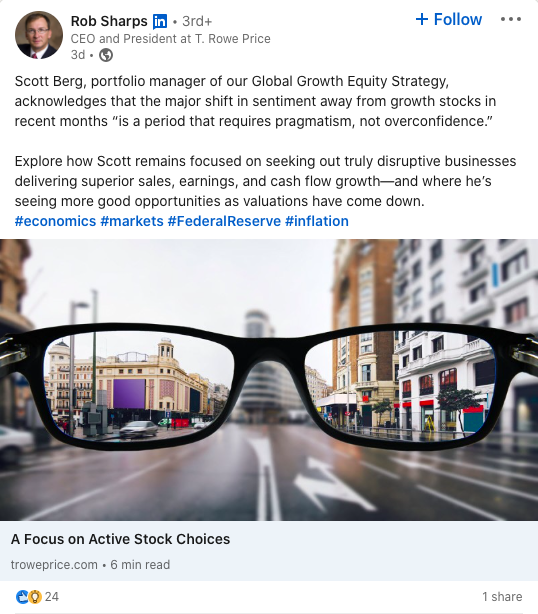This year, the Fortune 500 CEOs stepped up their game on social media with more individuals on the list having an online presence. Being on social media offers many benefits for industry leaders, such as helping them drive toward company objectives, establishing themselves as thought leaders, and connecting with customers, stakeholders, and current and potential employees.
Our team at Influential Executive researched each CEO on the Fortune 500 list to find how many of them have a social media account. As of August 2022, 70% of CEOs on the list have at least one social media account — an increase of 13% since 2020.
In this article, we look at three interesting Fortune 500 CEOs we recommend following on social media across LinkedIn, Twitter, and Instagram. We chose these CEOs because they utilize the benefits of their respective platform effectively to share engaging content with their followers.
Rob Sharps on LinkedIn
Unsurprisingly, LinkedIn is the top platform for Fortune 500 CEOs. 97% of those that have a social media presence have a LinkedIn account. LinkedIn is the most popular amongst CEOs because the professional networking platform focuses on business content. For many leaders (particularly those in B2B industries), their primary audience is also on LinkedIn, making it an effective platform to connect with potential clients and partners.
Rob Sharps, the president and CEO of T. Rowe Price, has a well-established LinkedIn presence with over 18,000 followers. His content tends to focus on business and employee accomplishments.

[Source]
Sharps focuses on highlighting his business by posting about different related topics. He shares articles from his employees that are posted on his company’s website (an effective way to drive traffic), posts about workplace culture, and shares his personal achievements. By continuously updating his LinkedIn feed with how the company is performing and other insightful thought leadership articles, he is catering to his audience’s interests and sharing more about his company in a less overtly promotional way.
This type of information coming from the CEO rather than the company page is a way to build trust with his audience. It becomes more personal and is an important step in building relationships on social media.
Sasan Goodarzi on Twitter
Sasan Goodarzi is the CEO of Intuit. On Twitter, most of his content centers on his business and family life. Goodarzi is an example of a CEO with an effective Twitter presence because he posts short direct messages that are also engaging and authentic. Unlike a platform like LinkedIn where posts can be a handful of paragraphs long, users on Twitter engage with content that is much shorter and quickly consumed. By commenting on his business accomplishments and endeavors, he is updating his followers by speaking from a more personal perspective.
Goodarzi rarely retweets from Intuit, which means his feed is full of unique content. While sharing posts from a company page from time to time is a valid strategy, the most effective executives on social media are the ones that create and share unique content that’s different from their company’s social media accounts.
The energy from our company-wide event was incredible. We unveiled a new @Intuit logo and brand identity, celebrated the end of a strong fiscal year, and shared our vision for a great year ahead. A huge thank you to our team and award winners for all you do to help our customers. pic.twitter.com/GJWtHRvhE6
— Sasan Goodarzi (@sasan_goodarzi) August 30, 2022
Discussing family life and other personal interests may seem like topics a CEO wouldn’t need to prioritize but on social media, being more authentic and personable is a strategy that leads to success and increased engagement. This type of content builds out an individual’s persona and is an excellent way to connect with other social media users. With Goodarzi, he posts about his wife, kids, and personal interests — and his followers respond well to it. They reply in the comments congratulating his kids, are interested in what’s happening in his life, and he often receives a higher amount of likes compared to other posts.
Thasunda Brown Duckett on Instagram
Instagram is not as popular among CEOs because each post requires a photo or video — both of which take time and effort to produce. However, while LinkedIn remains the top social media platform for Fortune 500 CEOs, Instagram has gained more C-suite users over the past few years. Of the Fortune 500 CEOs on social media, 14% have an Instagram account, which is a 133% increase since 2020. Now that more CEOs are open to exploring Instagram, let’s take a look at one individual with an established presence on that platform: Thasunda Brown Duckett, the CEO of TIAA.
Duckett utilizes all the features that Instagram has to offer by posting photos, Reels, Stories, and creating Story Highlights. Her content includes photos of her kids, motivational graphics, and Reels about business initiatives. A well-designed Instagram feed, high-quality graphics, authentic photos, and a strong voice all contribute to her effective social media presence.
Using Instagram for more personal posts is what users expect to see on this platform. They want to be entertained and engage with content they enjoy and find authentic. For many executives looking to join Instagram, one valuable source of photos is at conferences and other media events.
These CEOs Have Established Their Digital Presence
Each platform has various benefits that CEOs and executives can utilize to create relationships with their customers, stakeholders, and even employees. The three that we highlighted here are examples of business leaders that are making a real impact on social media — not only by being an identifiable face of their respective companies but also by supporting their company’s marketing efforts. If you want to learn more about our study, click here to read about our Fortune 500 social media research.
For executives who are looking to start their social media presence or marketers who need support in getting their company’s leaders online, our team can help! Click the button below to book a consultation with our experts and let’s discuss how to strategically position your executives online.


